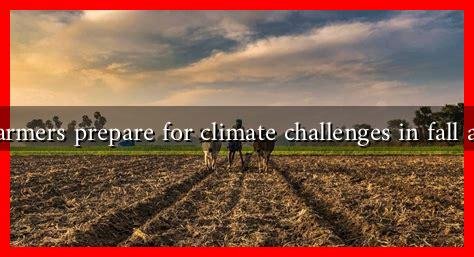-
Table of Contents
- How Can Farmers Prepare for Climate Challenges in Fall Agriculture?
- Understanding the Climate Challenges
- Strategies for Fall Agriculture Preparation
- 1. Crop Selection and Diversification
- 2. Soil Management Practices
- 3. Water Management Techniques
- 4. Pest and Disease Monitoring
- Case Studies and Success Stories
- Conclusion
How Can Farmers Prepare for Climate Challenges in Fall Agriculture?
As climate change continues to impact agricultural practices worldwide, farmers must adapt their strategies to mitigate risks associated with unpredictable weather patterns, pests, and diseases. Fall agriculture, in particular, presents unique challenges that require proactive measures. This article explores effective strategies that farmers can implement to prepare for climate challenges during the fall season.
Understanding the Climate Challenges
Farmers face a myriad of climate-related challenges during the fall, including:
- Unpredictable Weather: Sudden frost, heavy rainfall, or drought can significantly affect crop yields.
- Pest and Disease Pressure: Warmer temperatures can lead to increased pest populations and the spread of diseases.
- Soil Erosion: Intense rainfall can lead to soil erosion, affecting soil health and crop productivity.
According to the National Oceanic and Atmospheric Administration (NOAA), the frequency of extreme weather events has increased by 30% over the past few decades, making it imperative for farmers to adapt their practices.
Strategies for Fall Agriculture Preparation
Farmers can adopt several strategies to prepare for the challenges posed by climate change during the fall season:
1. Crop Selection and Diversification
Choosing the right crops is crucial for mitigating climate risks. Farmers should consider:
- Climate-Resilient Varieties: Opt for crop varieties that are more tolerant to drought, heat, and pests. For example, drought-resistant corn hybrids can thrive in less-than-ideal moisture conditions.
- Diverse Crop Rotation: Implementing a diverse crop rotation can help break pest cycles and improve soil health. For instance, rotating soybeans with corn can enhance nitrogen levels in the soil.
2. Soil Management Practices
Healthy soil is the foundation of successful agriculture. Farmers can enhance soil health through:
- Cover Cropping: Planting cover crops such as clover or rye during the fall can prevent soil erosion, improve soil structure, and enhance nutrient cycling.
- No-Till Farming: Reducing tillage can help maintain soil moisture and reduce erosion. A study by the Conservation Technology Information Center found that no-till practices can increase soil organic matter by 0.25% annually.
3. Water Management Techniques
Effective water management is essential for fall agriculture, especially in light of changing precipitation patterns. Farmers should consider:
- Rainwater Harvesting: Collecting and storing rainwater can provide an additional water source during dry spells.
- Drip Irrigation: Implementing drip irrigation systems can optimize water use and reduce evaporation losses.
4. Pest and Disease Monitoring
With climate change altering pest and disease dynamics, farmers must stay vigilant. Strategies include:
- Regular Monitoring: Conducting regular field inspections can help identify pest outbreaks early.
- Integrated Pest Management (IPM): Utilizing IPM strategies can minimize chemical use while effectively managing pest populations.
Case Studies and Success Stories
Several farmers have successfully implemented these strategies to combat climate challenges:
- Case Study: The Rodale Institute – This organization has demonstrated the effectiveness of organic farming practices, including cover cropping and no-till methods, in improving soil health and resilience against climate variability.
- Success Story: The Land Institute – By promoting perennial crops, this institute has shown that these crops can withstand extreme weather conditions better than traditional annual crops.
Conclusion
As climate challenges continue to evolve, farmers must adopt innovative strategies to ensure the sustainability of fall agriculture. By focusing on crop selection, soil management, water conservation, and pest monitoring, farmers can enhance their resilience against climate variability. The proactive measures outlined in this article not only help mitigate risks but also contribute to long-term agricultural sustainability. For more information on sustainable farming practices, visit Sustainable Agriculture Research and Education (SARE).

